TFT (Thin Film Transistor) - Liquid crystal displays based on active matrix thin film transistors. For each pixel there are three transistors corresponding to three colors (RGB - red, green, blue). On this moment, these are the most common displays that have a number of advantages over other displays. They have a minimum response time and rapid development- constantly growing resolution and number of colors. These displays are most common in mid-range phones and above. Working resolutions for them: 128x160, 132x176, 176x208, 176x220, 240x320 and others less common. Examples: Nokia N73 (240x320, 262k colors), Sony Ericsson K750i (176x220, 262k colors), Samsung D900 (240x320, 262k colors). TFTs are very rarely used as external clamshell displays.
CSTN (Color Super Twisted Nematic) - Color liquid crystal displays with a passive matrix. Each pixel of such a display consists of three combined pixels, which correspond to three colors (RGB). Some time ago, almost all phones with color displays were based on this type. And now the lot of such displays is budget models. The main disadvantage of such displays is their slowness. The undoubted advantage of such displays is their cost, which is much lower than TFT. Based on simple logic, we can assume that in the future TFT will displace this type of display from the mobile device market. The evolution of the color of such displays is quite extensive: from 16 to 65536 colors. Examples: Motorola V177 (128x160, 65k colors), Sony Ericsson J100i (96x64, 65k colors), Nokia 2310 (96x68, 65k colors).
UFB (Ultra Fine and Bright) - Liquid crystal displays with increased brightness and contrast on a passive matrix. We can say that this is an intermediate option between CSTN and TFT. This type of display boasts lower power consumption compared to TFT. For the most part, such displays were used Samsung in mid-range phones. This type displays are not widely used. Examples: Samsung C100/110 (128x128, 65k colors).
TN is one type of TFT screen matrix. Roughly speaking, TN are the simplest and cheapest TFT matrices. The viewing angles are the narrowest.
2,644 - 5,643 rubles. (Average price: 2,990 rubles)
General characteristics
Type smartphone OS version Android 4.4 Case type classic Control touch buttons Number of SIM cards 2 Multi-SIM mode variable Weight 115 g Dimensions (WxHxD) 61.6x111x9.9 mmScreen
Screen Type Color TFT, Touch Type touch screen multitouch, capacitive Diagonal 3.5 inches. Image size 480x320 Automatic screen rotation yesMultimedia features
Camera 2 million pixels, built-in flash Video recording yes Front camera yes, 0.3 million pixels. Audio MP3, FM radio 3.5 mm headphone jackConnection
Standard GSM 900/1800/1900, 3G Interfaces Wi-Fi 802.11n, Bluetooth, USB Satellite navigation GPSMemory and processor
Processor MediaTek MT6572M, 1000 MHz Number of processor cores 2 Video processor Mali-400 MP Built-in memory 512 MB Volume random access memory 256 MB Memory card slot yesNutrition
Battery type Li-Ion Battery capacity 1300 mAh Micro-USB charging port typeOther features
Voice dialing control, voice control Airplane mode yesAdditional Information
Announcement date 2015-08-27 Sales start date 2015-08-28Reviews
Advantages
good case plasticFlaws
Very little memory, constant software errors.A comment
Some errors in the software constantly pop up, the sound from the speaker, like in the phone of the 50s. The highscreen service is terrible, you won't get an answer when you contact the Internet. The purchase of this model can be wished only to the enemy. I'll try to return and forget forever highscreen like a bad dream.Advantages
DaseinFlaws
All the restA comment
I bought this device for a child, I didn’t even put Google Chrome on my home. not to mention other applications. Do not buy this item. I wanted to change to a more expensive model, they said it was scratched on the side of micro scratches. It is not known if they were. refused to exchange.Advantages
1) Price2) 2 SIM cards3) Micro SD slotFlaws
1) The RAM (Ram) is not just not enough, but the android itself barely pulls in, and what can we say about VK and other applications 2) Built-in memory (512mb - a funny figure) 3) Performance below the plinth 4) It heats up like an iron. Cuts out5) Battery drains in three hours active use at minimum brightness6) Constant glitches and crashes as a result of low tech. characteristics.7) Quiet and rustling speakers. The sound quality is almost zero 8) The camera is just for show. 9) The build quality is terrible. crunches like a plastic bag10) Very inconvenient to use: the body is angular and slippery, the buttons are uncomfortable and the bottom ones are not highlighted11) The viewing angles at the screen are terrible 12) There is almost no sense from the memory cardA comment
Don't buy this, let's say, device. Spoil your nerves and throw away money.Advantages
definitely the price, two sim cards, dimensions, funny designFlaws
doesn't work very well.A comment
I didn’t buy it for myself, but for my mother, it turned out to be a great option for her. both small and modern, and mom does not get mad when the phone dulls, but calmly waits for it to come to its senses)))According to the characteristics, a lot of things do not suit me, but I would like to draw attention to the fact that the Highscreen company works on both thick and leaky wallets, thanks for that)))
Advantages
- Bright- Stylish
- Not expensive
- Not a bad screen
Flaws
- Very slow- Very truncated
- There is not enough memory so much that I can’t even set a third-party alarm clock, not to mention changing the browser and adding a couple of toys
- Doesn't hold a charge well
- Body materials: plastic
- operating system: Google Android 4.4
- Network: GSM / GPRS / EDGE / 3G, two SIM cards of the miniSIM + microSIM standard
- Processor: 2 cores, MediaTek MT6572M
- RAM: 256 MB
- Storage Memory: 512MB
- Interfaces: Wi-Fi (b / g / n), Bluetooth 4.0, microUSB connector (USB 2.0) for charging / synchronization, 3.5 mm for a headset
- Screen: capacitive, IPS 3.5 "" with a resolution of 240x320 pixels
- Camera: 2/0.3 MP, flash
- Navigation: GPS
- Optional: accelerometer, proximity and light sensors, FM radio
- Battery: removable, lithium-ion (Li-Ion) 1300 mAh
- Dimensions: 111x61x9.9mm
- Weight: 115g
Introduction
Last year, a miniature smartphone from Vobis Computer (Highscreen) came out, accidentally left without my attention. However, no wonder: many observers have bypassed it, because the gadget has rather simple technical characteristics. At the moment, Pure J costs less than 3,000 rubles. For whom is this model suitable? It seems to me that those who are completely uninterested in processors, chips, memory, IPS or AMOLED matrices, cameras, and so on, but Android is important in order to install a couple of important programs, two SIM cards, extremely small dimensions and at least a more or less decent appearance. Of course, the design of Pure J is also not all right, but the user can choose one of the five colors of the back cover: black, white, orange, blue or yellow.
Design, dimensions, controls
The Pure J smartphone inherits the design of the Pure F, which, in turn, retained the external resemblance to the Jolla device on Sailfish OS. That is, the body consists of two halves: backside rectangular shape, and the reverse is flat, but the corners are decorated with a semicircle. It turns out a two-layer "pie". Looks good.
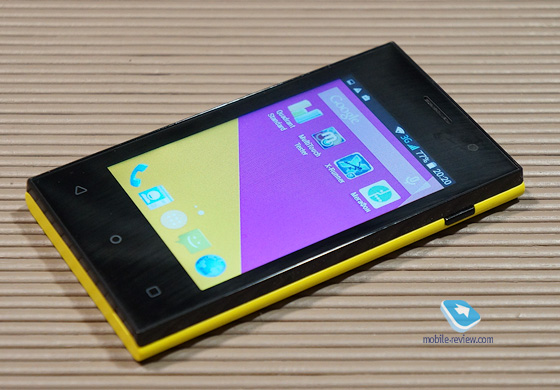
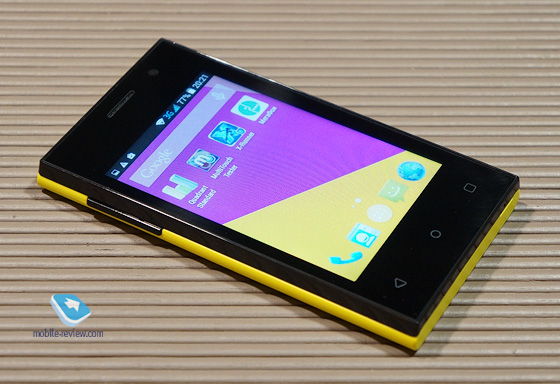
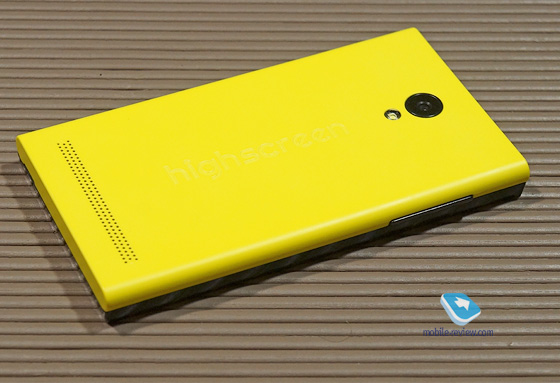
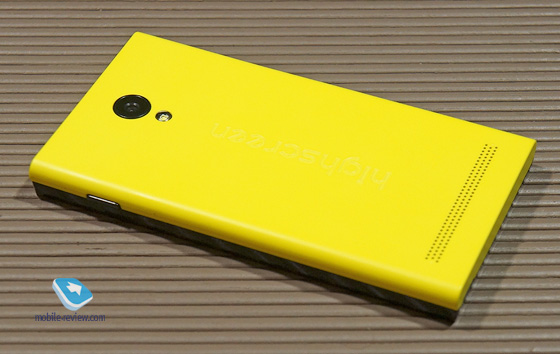
As I wrote in the introduction, the device is available in several colors, or rather, covers of different colors are available. Alas, you will not find an additional panel in the kit, but it would be great, since Highscreen has already experimented in this direction. Probably, the manufacturer tried to save as much as possible on Pure J. As far as I know, all covers are matte, pleasant to the touch, the colors are quite bright.
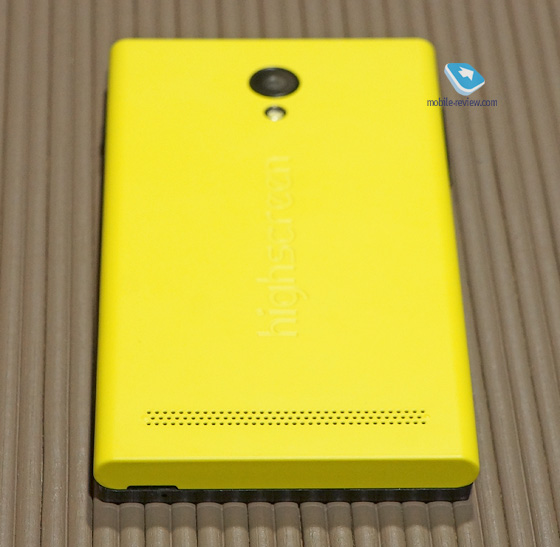
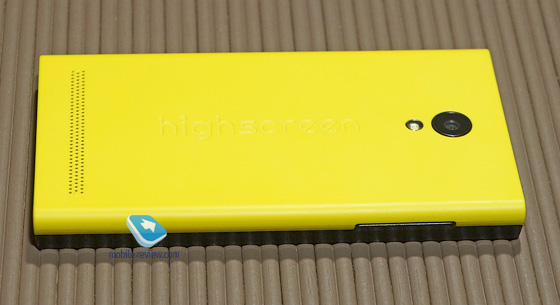
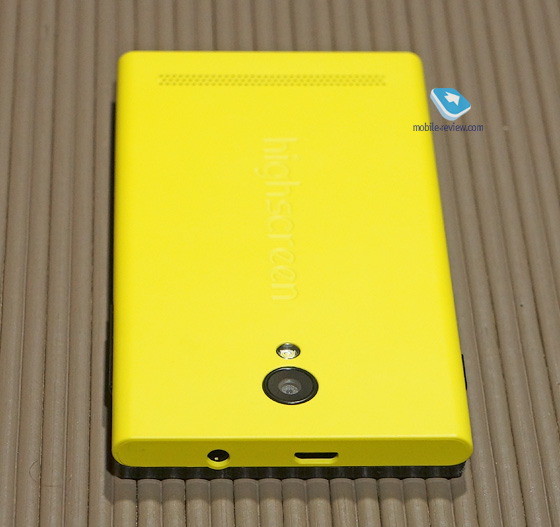
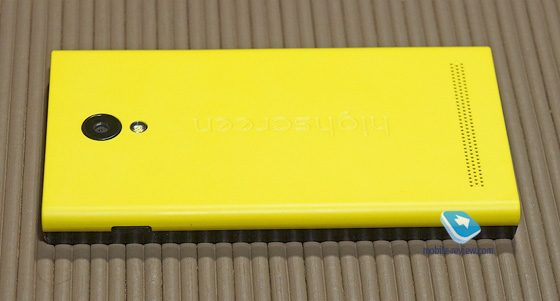
Dimensions are small - 111x61x9.9 mm, after the "shovel" type samsung galaxy Note, the LG G4 or Meizu Pro Highscreen feels so small and easy to handle that it makes you want to use it for a while. However, it disappears when it becomes necessary to quickly type text on the keyboard, take photos, post them to colleagues at work, or something similar.
The weight of the phone is 115 grams, about the same as Apple iPhone 5.
Despite the low cost, the Pure J screen has an oleophobic coating, and good quality: the prints are almost invisible, they are erased quickly, the finger glides easily. Material - glass.
Assembled Pure J for a triple with a plus or a four with a minus. Over time, the lid began to creak. Everything else is good.
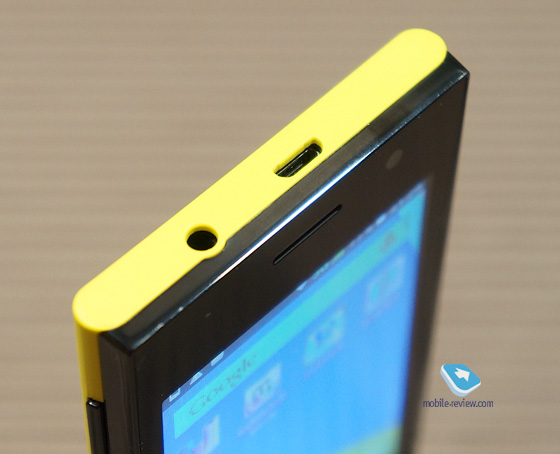
The loudspeaker is in the top center. It has a volume slightly above average, the quality is so-so: it creaks on ringing notes, the sound is booming. To the right of the speaker is the front camera.
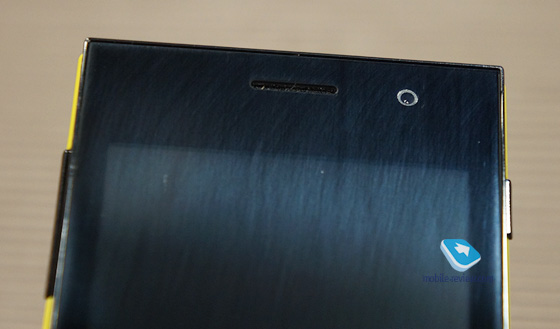
Below the display are the control buttons. They are not illuminated, marked with silver paint.
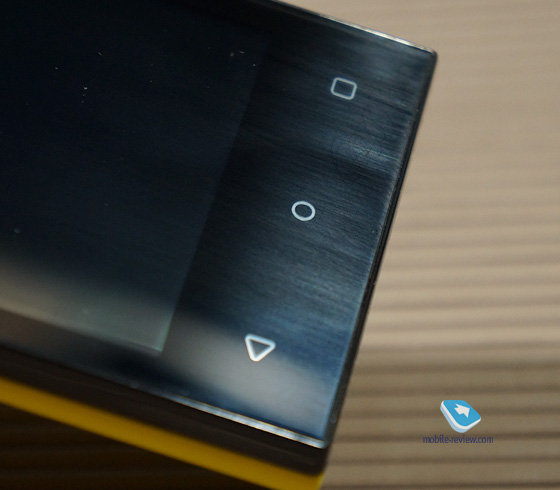
Microphone - on the bottom, microUSB and 3.5 mm - on the top. On the left is the volume rocker, on the right is the power button. Relatively easy to use. Material - black glossy plastic.
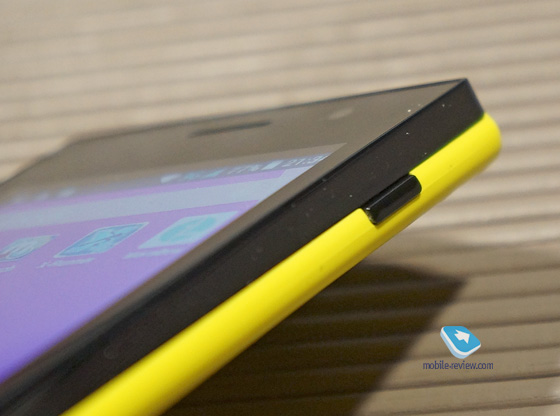
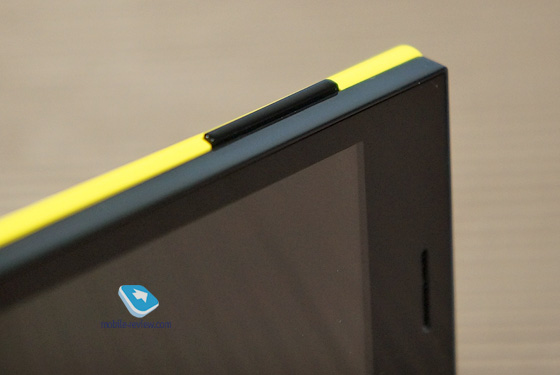
WITH reverse side there is a camera recessed into the body, a small LED flash, a slot where the speaker is located.
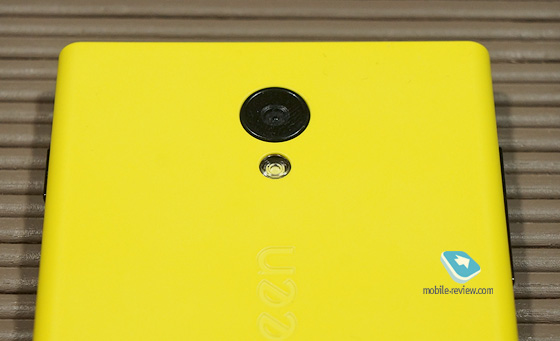
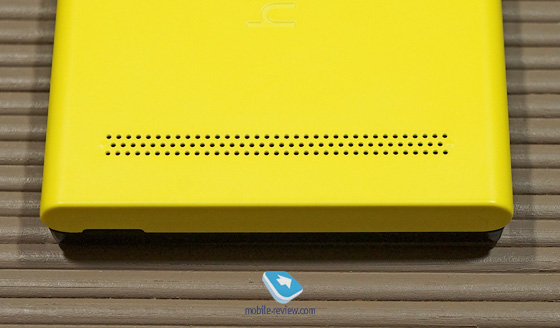
The back panel is removable. Below it at the top are slots for microSIM and miniSIM, as well as a microSD slot.
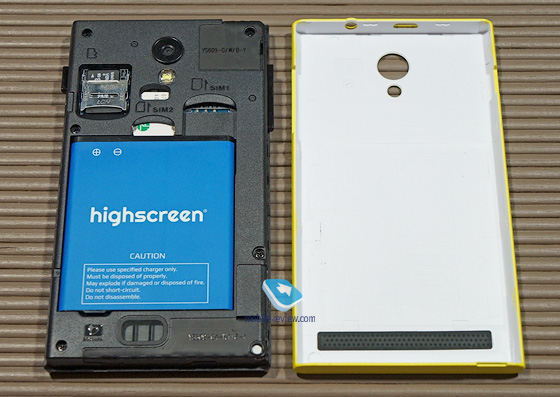
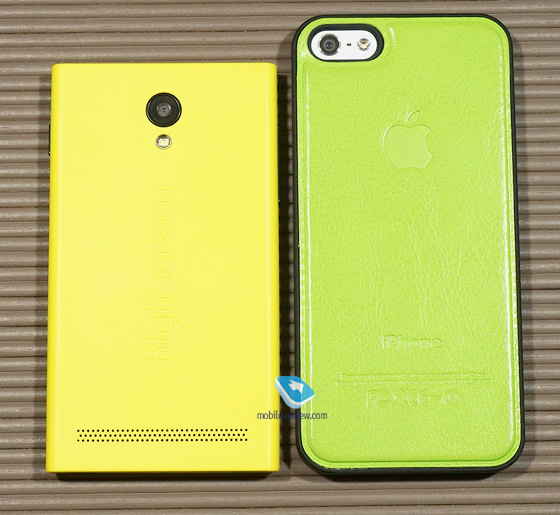
Display
This device uses a 3.5-inch screen. The physical size is 74x49 mm, the frame on top is 17 mm, on the bottom is 19 mm, on the right and left are about 6 mm each. There is no anti-reflective coating.
The Pure J display resolution from Highscreen is HVGA, that is, 320x480 pixels, the aspect ratio is 3:2, and the density is 164 pixels per inch. The matrix is not IPS, with an air gap.
Maximum brightness white color– 350 cd/m2, maximum black brightness – 0.65 cd/m2. Contrast - 550:1.
Since the matrix is not IPS, the picture, frankly, is disappointing: when the display deviates from itself, the colors fade sharply, when tilted towards itself, they are sharply inverted. The touch layer fulfills 2 touches.
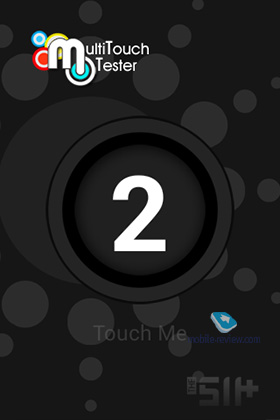
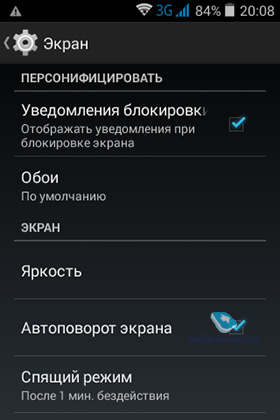
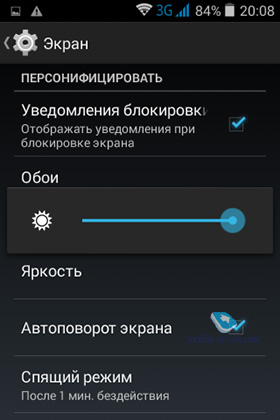
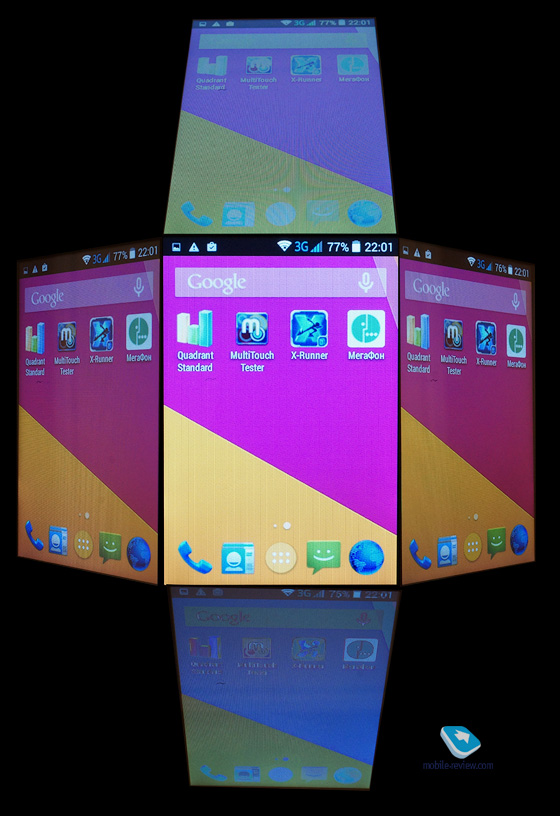
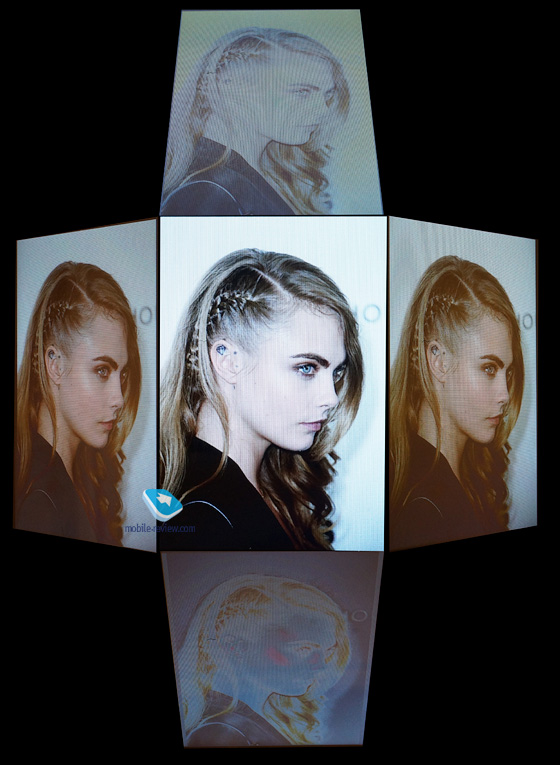
Battery
This model uses a removable lithium-ion (Li-Ion) battery with a capacity of 1300 mAh. The manufacturer does not provide data on battery life.
In my conditions Highscreen Pure J "lived" for about 8-9 hours: for the whole time about an hour of calls, 4-5 hours of 3G, a couple of hours of Wi-Fi, a camera - 20 minutes, about an hour of listening to music. In a more gentle mode, Pure F functions until the evening.
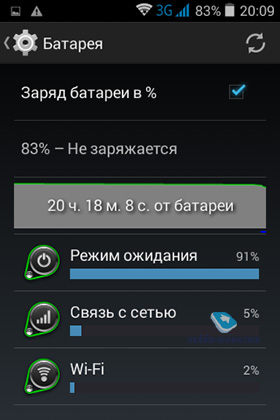
From a regular network adapter, the smartphone is charged up to 100% in about two hours.
Communication options
The device supports GSM/GPRS/EDGE (850/900/1800/1900 MHz); 3G/HSPA+ (900/2100 MHz). Otherwise, a typical Android set: Wi-Fi b / g / n, Bluetooth 4.0, GPS (satellites are reluctant to look for, but the accuracy is good). OTG mode does not work.
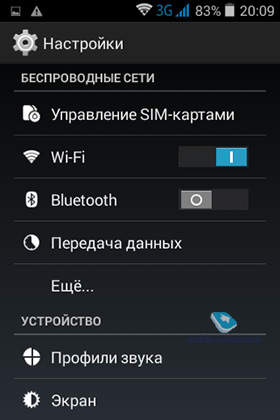

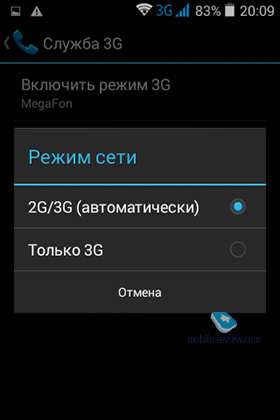
Memory and memory card
Inside, there is only 256 MB of RAM, which is only enough for a couple of applications in the background. Built-in memory is also small - 512 MB. Unfortunately, the camera will require a memory card to work, and for everything else. Naturally, there was a slot for it, the maximum volume is 32 GB.
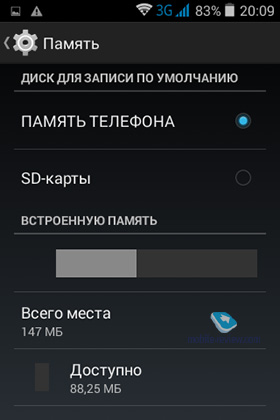
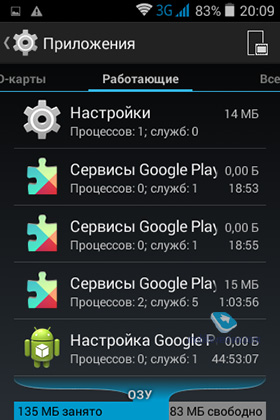
cameras
The Highscreen Pure J device is equipped with two camera modules: the main one with 2 MP without autofocus, the front one with 0.3 MP. There is a flash.
The camera modules in this device are pain and sadness. Instead of 2 MP, there is probably 0.3 MP here (interpolation). If you take a picture of a sheet of A4 format, where the text is printed in 12-14 font, then most likely it will be difficult to make out the letters.
The device records video at a resolution of 854x480 pixels at 15 frames per second. The sound is great. The quality of the video is definitely higher than the photo. Therefore, it is better to make mini-rolls than photos :)
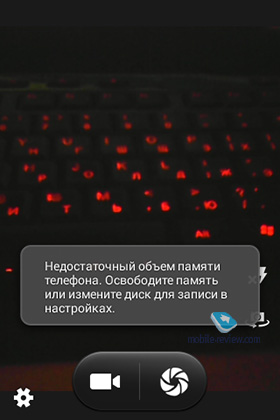
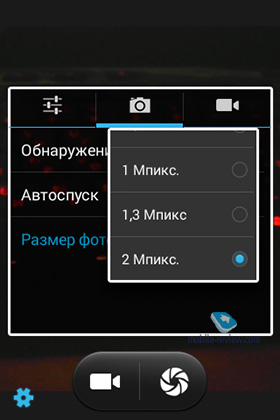
Photo examples
Performance
The Highscreen Pure F smartphone runs on the old Taiwanese MediaTek MT6572M chipset. It uses a dual-core processor with a clock speed of 1 GHz for each core. The graphics are Mali-400.
The interface slows down a little, slows down, there are shell friezes. By itself, the smartphone is slow, it is difficult to perform certain functions. But if the memory is not clogged with applications, then Pure J can be used without problems.
Welcome participants Club of Experts, as well as all the guests who visited this page.
This time, HIGHSCREEN decided to please economical users, who in the smartphone, first of all, the function of making calls is important. New model was named HIGHSCREEN PURE J. This device is available on the market in five different colors. I will try to tell about other characteristics, advantages and disadvantages in this review.
Specifications
Type: smartphone
Model: HIGHSCREEN PURE J
Operating system: Android 4.4
Processor: MediaTek MT6572M
Processor frequency: 1000 MHz
Number of processor cores: 2
GPU: Mali-400MP
Built-in memory size: 512 MB
RAM size: 256 MB
Screen technology: TFT
Screen Diagonal: 3.5"
Screen resolution: 480x320
Touch screen type: capacitive
Multitouch: yes
Bluetooth support: yes
WiFi support: yes
WiFi Standard: 802.11b/g/n
Wireless module: 3G
GPS: yes
Front camera: yes
Number of megapixels of the front camera: 0.3
Rear camera: yes
Number of megapixels of the rear camera: 2.0
LED flash: yes
Memory expansion slot: yes
Memory card form factor: micro SD, micro SDHC
The maximum size of the installed memory card: 32 GB
Built-in microphone: yes
Built-in speaker: yes
Type of USB connectors: micro USB
Audio jacks: headphone/audio output
Headphone jack type: mini-jack 3.5 mm
Headset connectivity: yes
Ability to use two SIM-cards: yes
SIM card form factor: mini-SIM, micro-SIM
GPS receiver: yes
Sensors: accelerometer
Automatic screen orientation: yes
Battery: Li-Ion
Battery capacity: 1300 mAh
Body material: plastic
Black color
Dimensions: 61.6x111x9.9 mm
Weight: 115g
Package
HIGHSCREEN PURE J is sold in a beige box that is already familiar to us. Its overall dimensions are small and amount to 134x75x52 millimeters, while the weight is 256 grams.
On the top side there is an image of the device without a back cover, here you can find information about the processor, battery, camera, networks, the amount of built-in and RAM. At the very bottom is the address of the official website and the name of the model.
![]()
On the left side there is a sticker with three barcodes. In the upper right corner is a circle marking the color of the model. IN this case black smartphone.
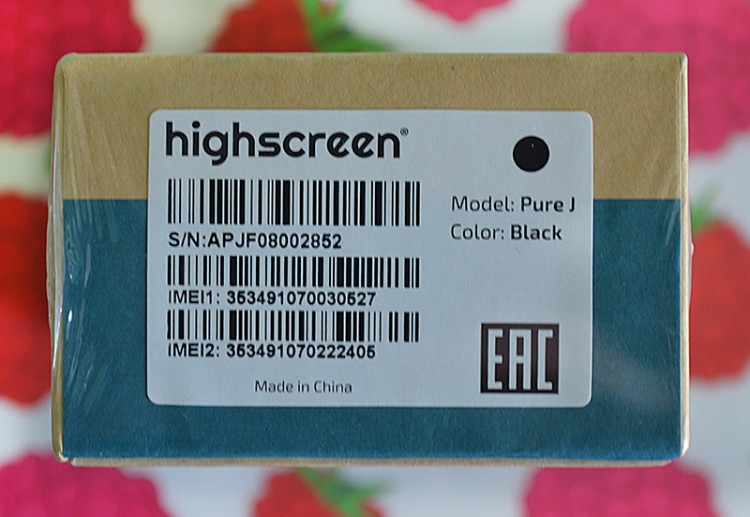
On the right side there is only the name of the model.
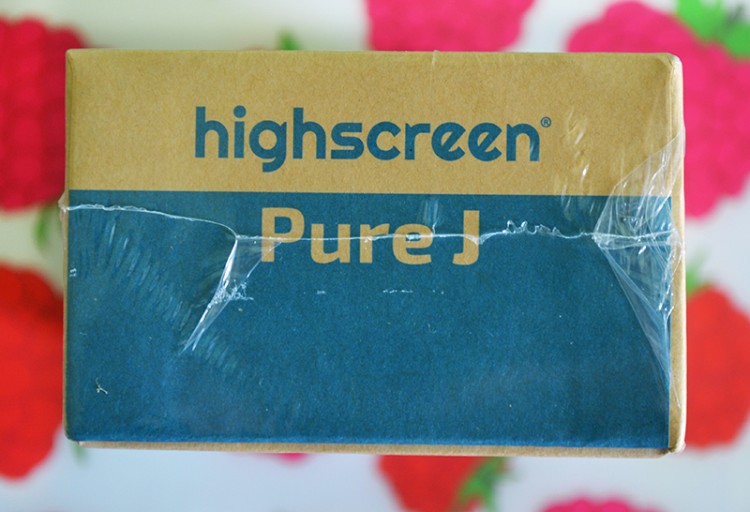
The model name is also duplicated on the back and front side.
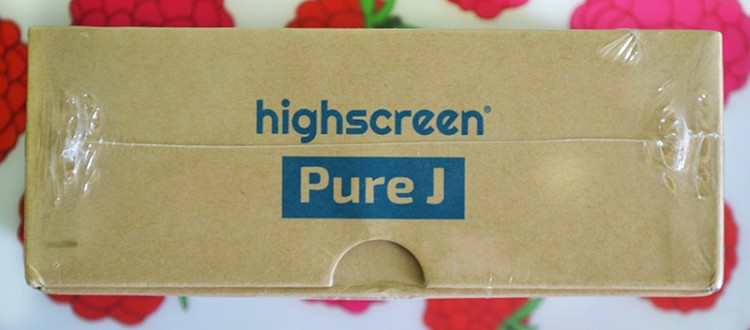
On the bottom side there is a model name, a barcode, a QR code, a website address, a place of assembly and development. There is also information that the amount of available memory is less than stated in the technical specifications, since some of it is used by the smartphone's operating system.
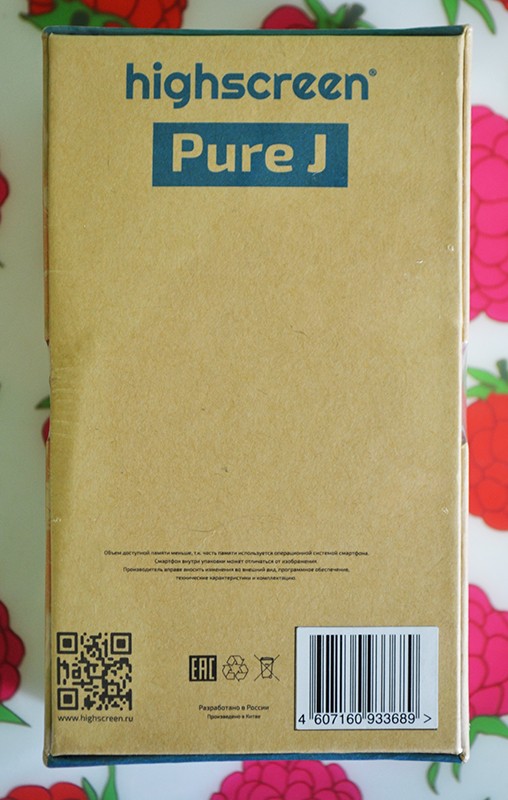
The box is packed in transparent plastic, so there is no need to fix the top cover with stickers, as you can see on previous models.
The packaging is compact, the description of the technical characteristics is partially present. There is even a HIGHSCREEN PURE J image, too bad it's not in color. The box is made in the style of past models, there is nothing new here.
Equipment
HIGHSCREEN PURE J has a small package. It includes:
- documentation
- USB network adapter
- headset
- microUSB to USB cable
As in previous models, the HIGHSCREEN PURE J documentation has been expanded. Except quick guide user and warranty card, it includes two sheets additional information. The first shows the correspondence between slots for SIM and flash cards, and the second shows a list of pages in all popular in social networks, where you can find out the news of HIGHSCREEN.
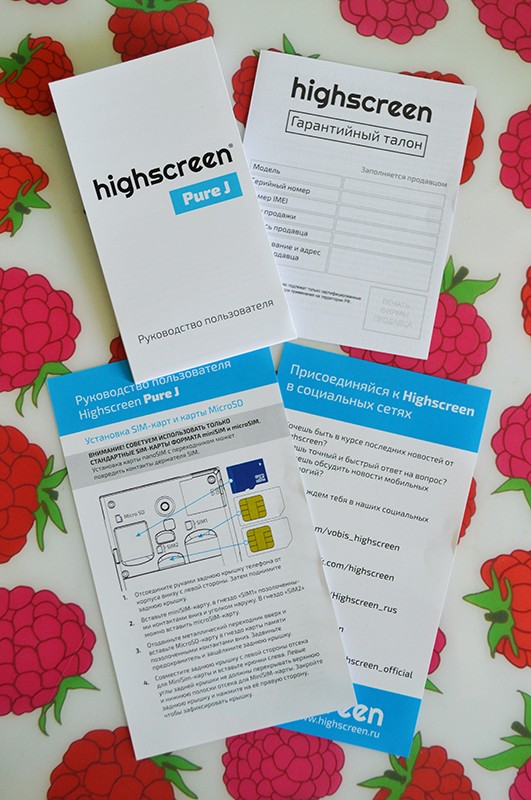
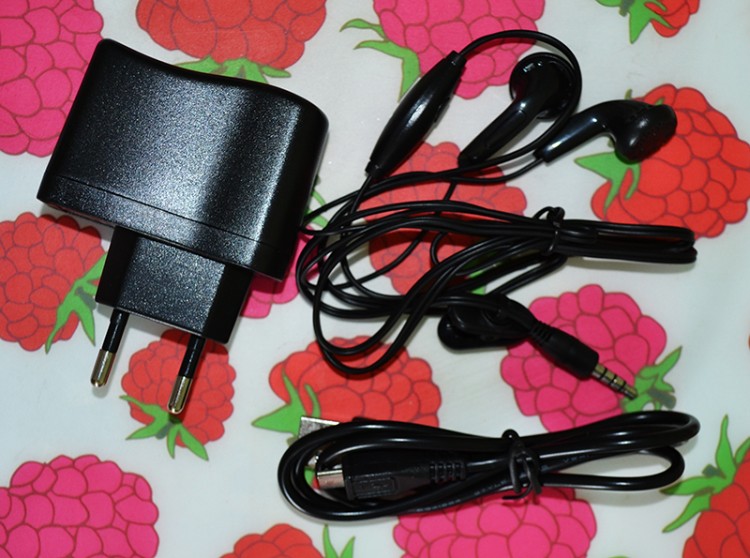
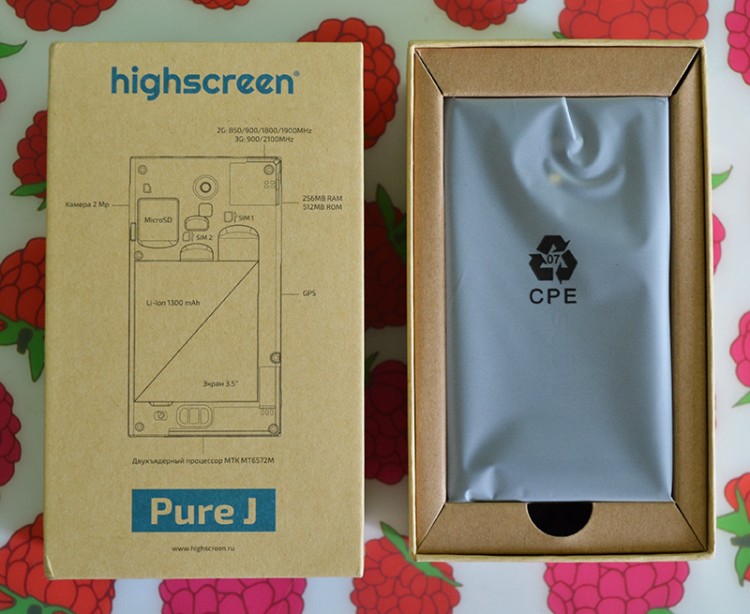
The headset is not of particular value, and here only for show.
All components are packed in separate plastic bags.
Appearance
HIGHSCREEN PURE J has a rectangular shape, the corners are not rounded. The overall dimensions of the smartphone are 61.6x111x9.9 millimeters, and the weight is 115 grams.
Almost the whole area front side occupies a 3.5-inch screen. On the sides, the edging is 4 millimeters, below and above 16 millimeters.
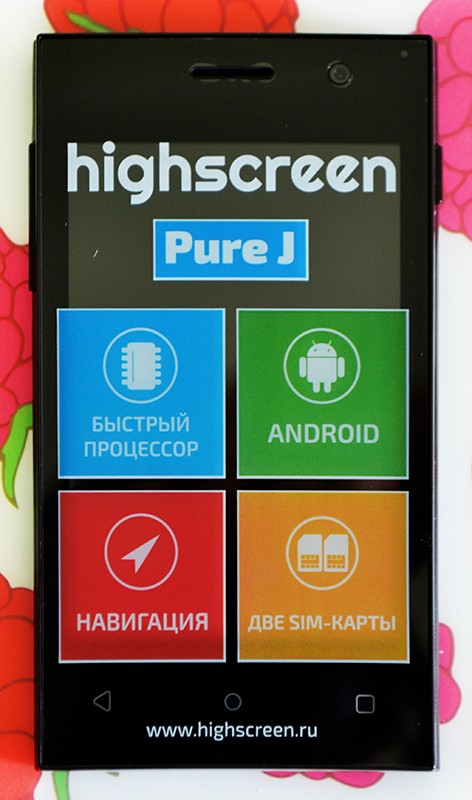
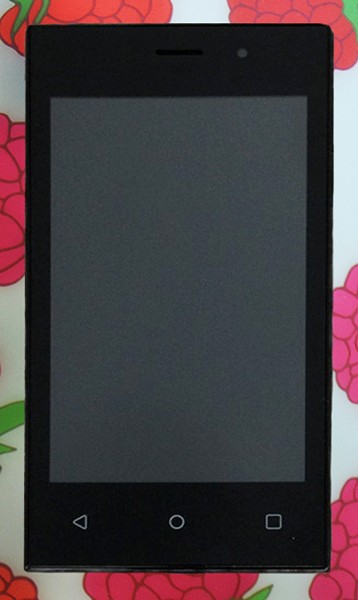
There is a hole on top of HIGHSCREEN PURE J conversational speaker, and on the right is a 0.3 MP front camera.
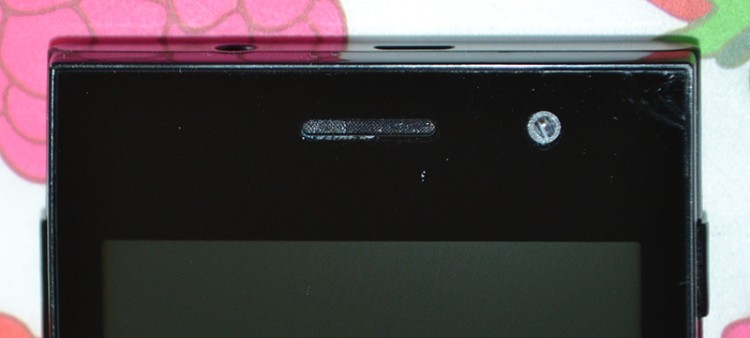
Below are three touch buttons highlighted in white. Even in low light, they are clearly visible.
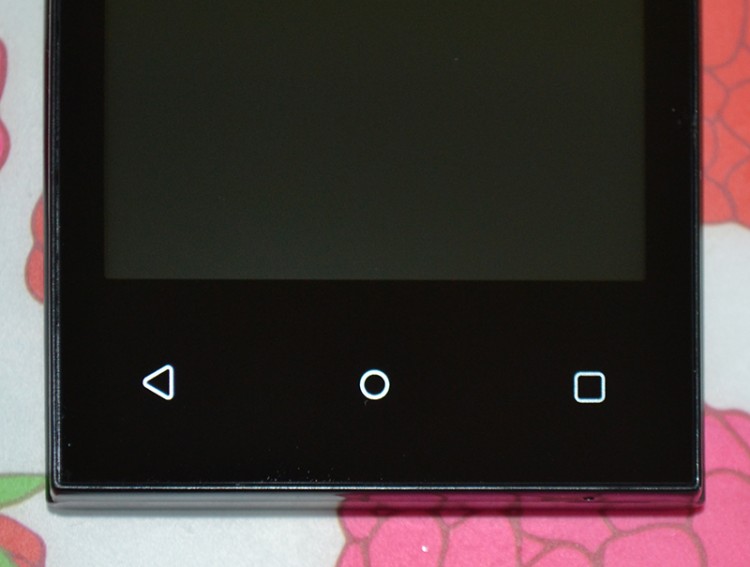
On the left side of HIGHSCREEN PURE J there is a volume control key.

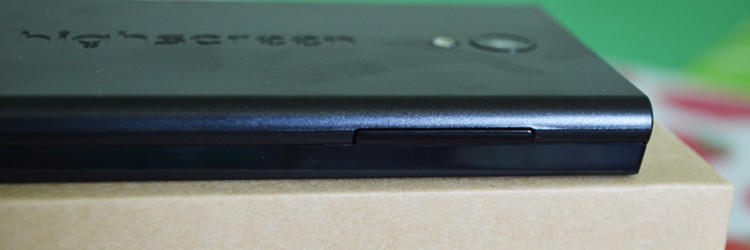
On the right side you can see the lock / power button.
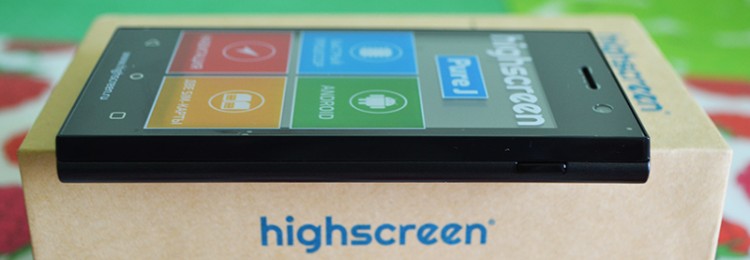
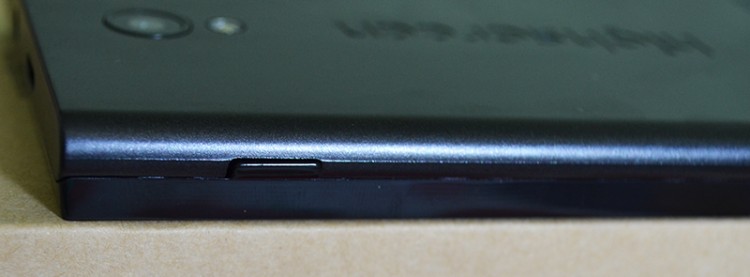
These controls protrude one millimeter from the case and are therefore easy to find with your finger.
On the top side there is a 3.5 mm mini-jack headset jack and a microUSB port for synchronizing the device with a computer and charging.

On the bottom side there is only a microphone hole and a rectangular slot designed for easy removal of the back cover.
![]()
The back panel of HIGHSCREEN PURE J is made of matte black plastic.
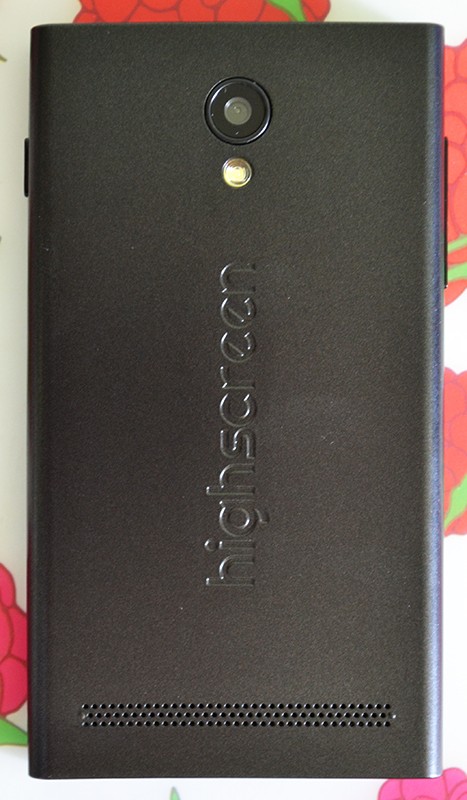
In the top center is the main camera 2 MP, below - LED flash.
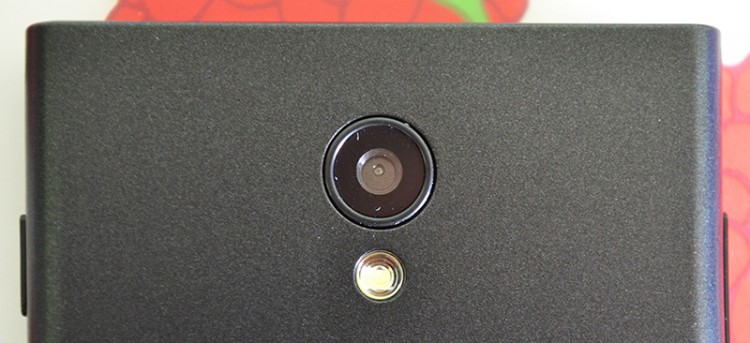
The HIGHSCREEN logo is placed vertically in the center of the rear panel.
There is a three-row perforation on the bottom, used as a speaker grille.
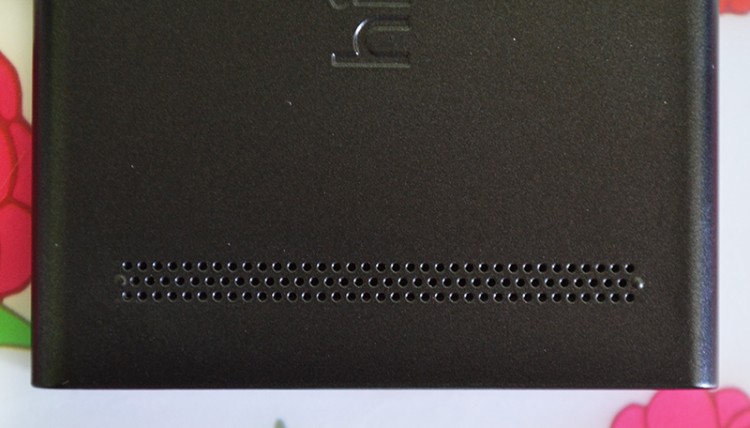
Removing the rear panel, you can see the slot for a micro SD / micro SDHC flash card. To the right are two slots for SIM-cards. The most interesting thing here is that HIGHSCREEN PURE J can simultaneously use two different SIM card form factors: mini-SIM and micro-SIM.
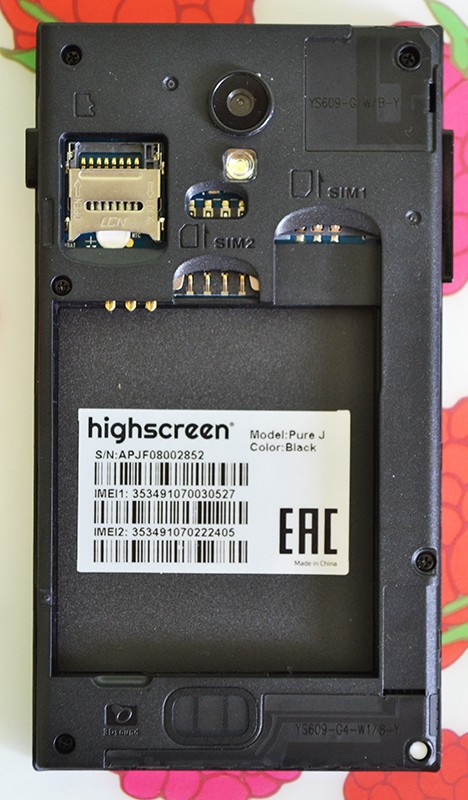
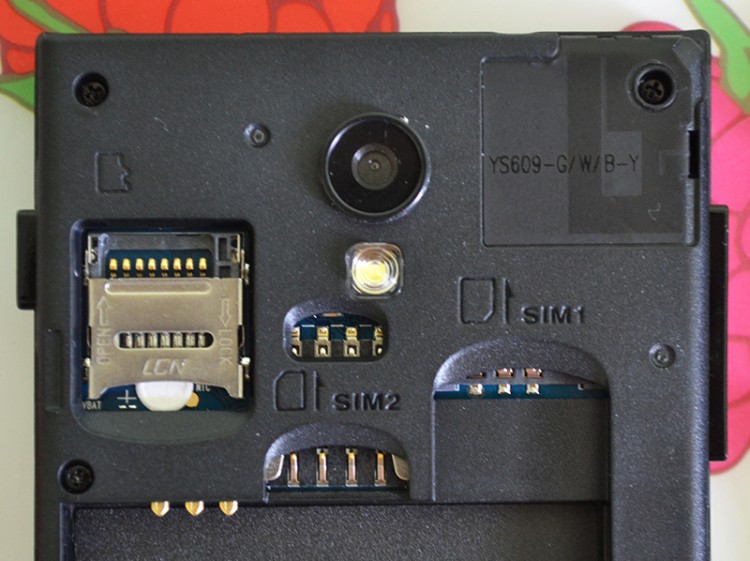
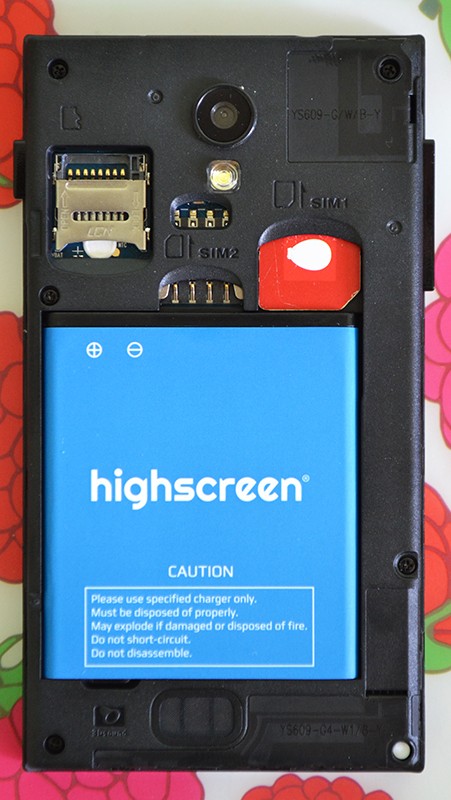
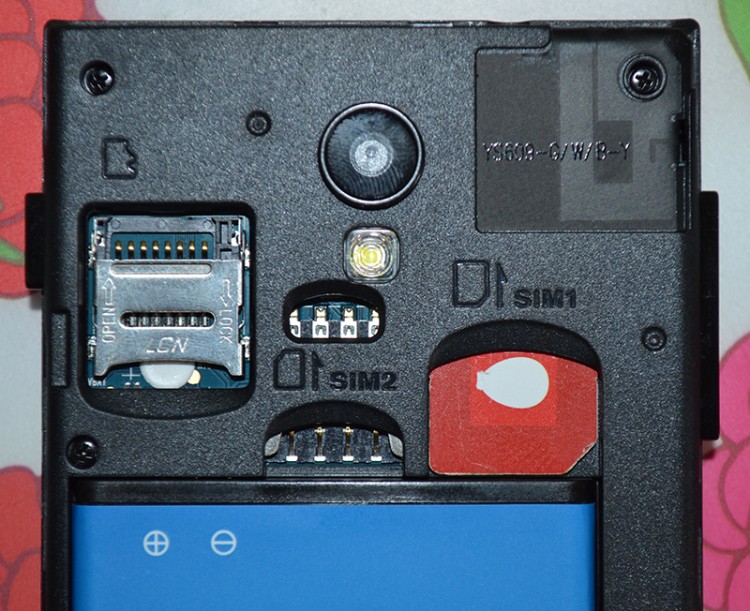
The battery in the smartphone is removable at 1300 mAh. Under it is a sticker with serial numbers.
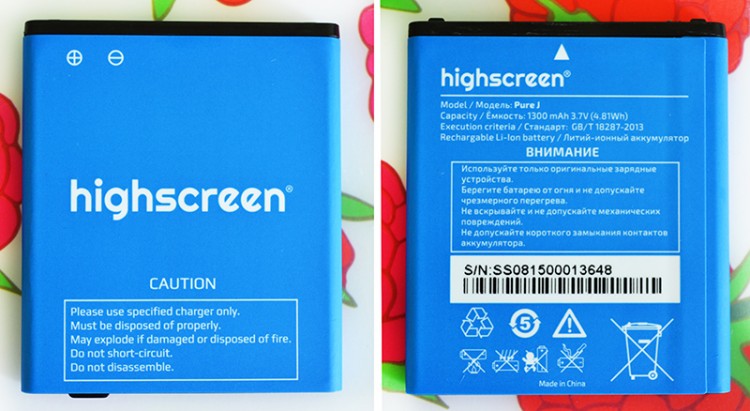
At the very bottom you can see the speaker hole.
A little off topic, I want to say that HIGHSCREEN PURE J has several color options: white, black, orange, yellow and blue.
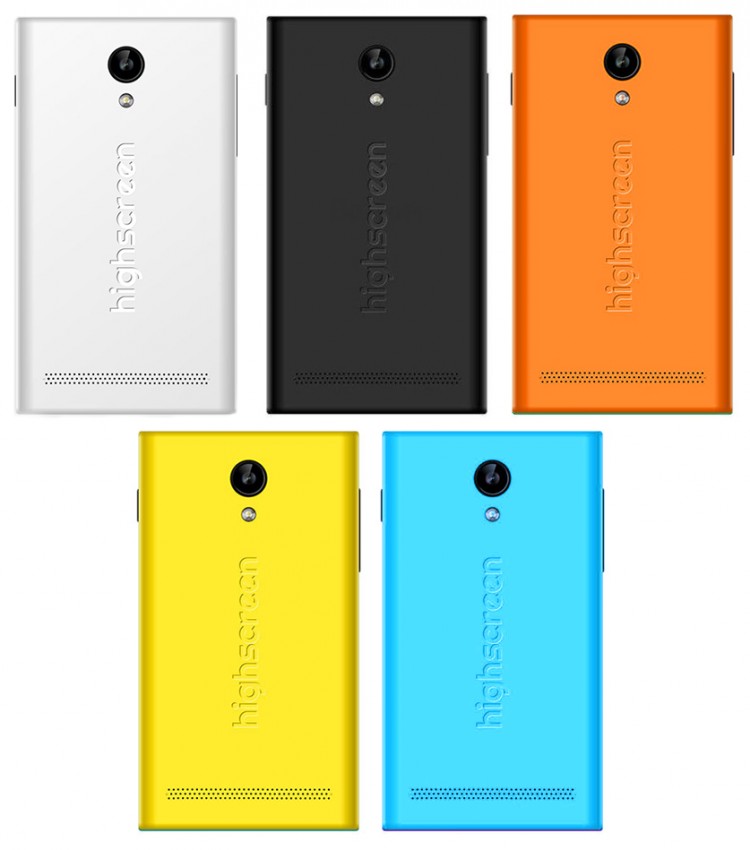
Appearance HIGHSCREEN PURE J practically does not differ from the previous models of the company. There are no questions about the assembly, all parts fit snugly together.
Screen
The HIGHSCREEN PURE J uses a TFT screen. Its diagonal is 3.5 inches, and the resolution is 480x200 pixels. Lights on the sides are present, but not very noticeable.
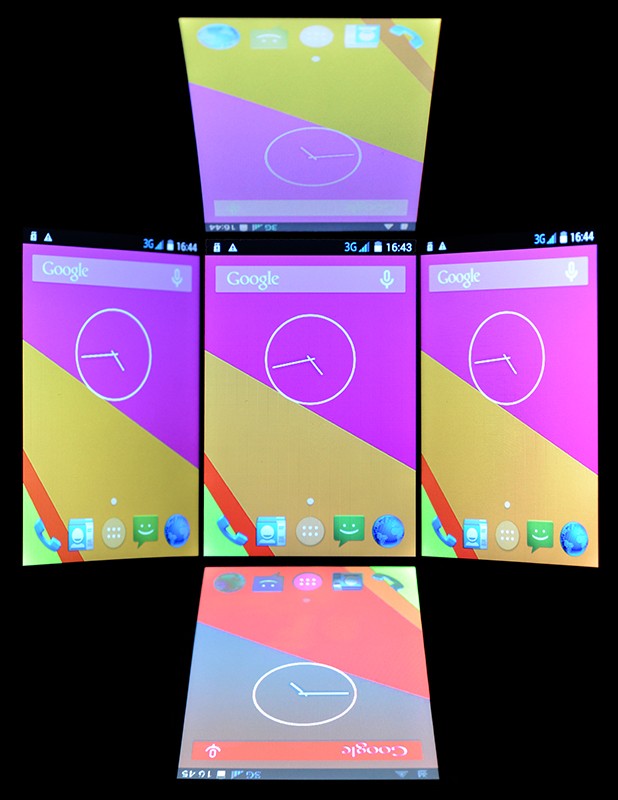
The quality of the picture is at a satisfactory level. The display supports the simultaneous touch of up to two fingers, this is quite enough to perform the simplest operations for which this smartphone is intended.
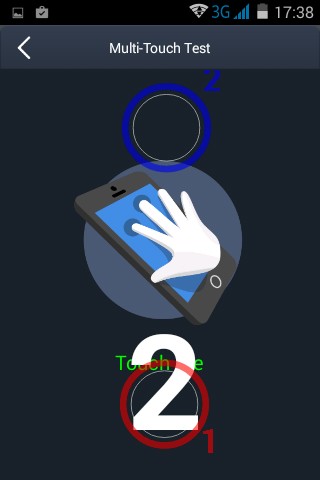
When hit by a direct sunlight the image on the screen becomes dark and therefore partially invisible.
The sensor is fast and sensitive.
It is clear that the HIGHSCREEN PURE J screen is far from ideal, but in the range budget smartphones looks pretty decent.
Interface
HIGHSCREEN PURE J works under operating Android system 4.4. Immediately after turning on the smartphone, the HIGHSCREEN branded splash screen appears on the screen, which is known to us from previous models. After that, you need to go through a short registration account, by the way, you can skip it.
HIGHSCREEN PURE J comes pre-installed with one desktop.
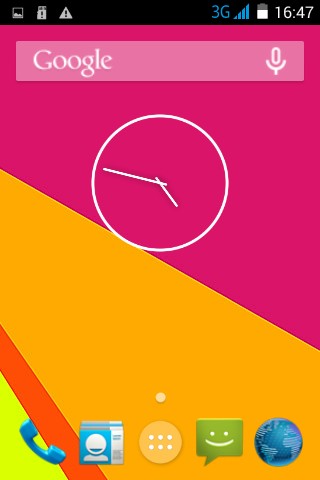
The standard set of applications is located on two menu pages.
The settings menu has a familiar look.
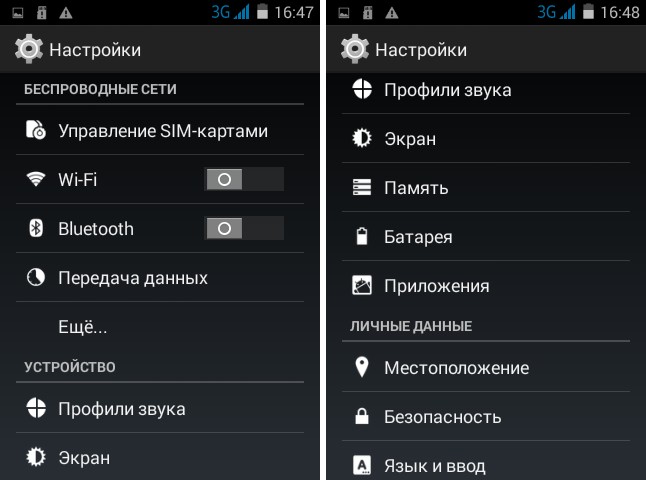
Menu bar with quick settings has the form of cells, it contains all the necessary elements.
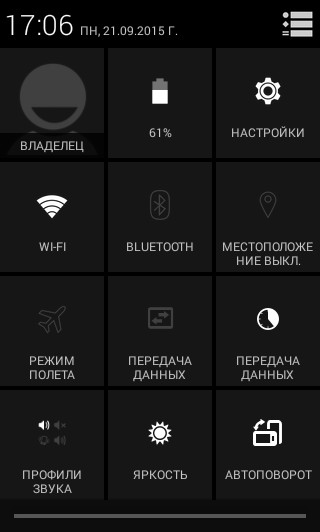
With a long touch on the main screen, you can go to the main page control menu. Here you can change the wallpaper, as well as get fast access to widgets and settings.
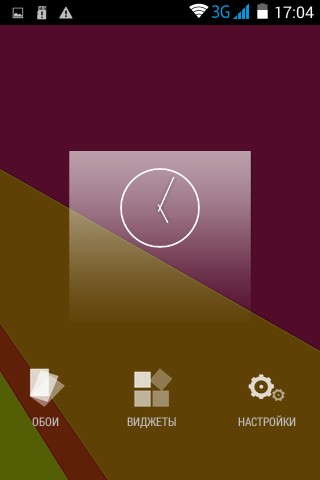
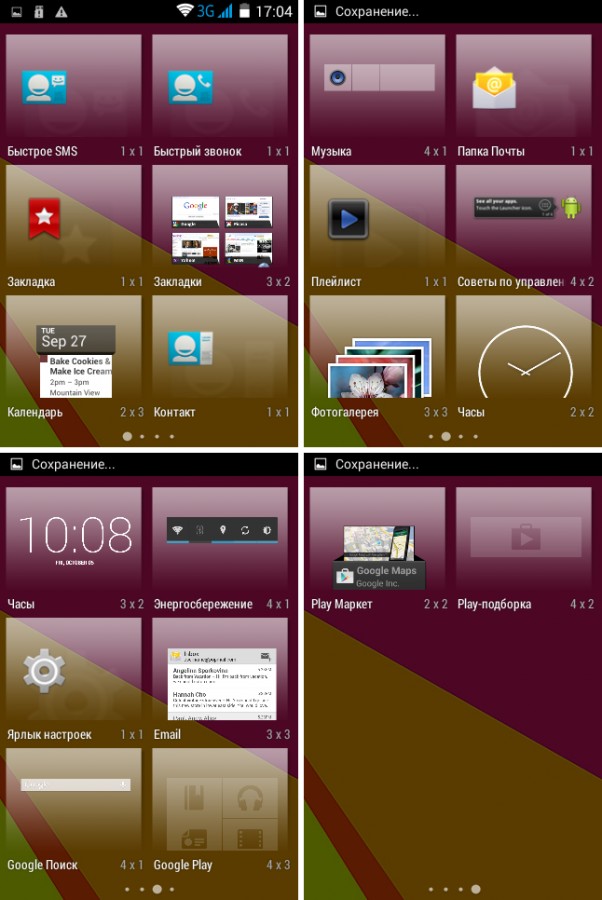
The smartphone has a very wide range of wallpapers.
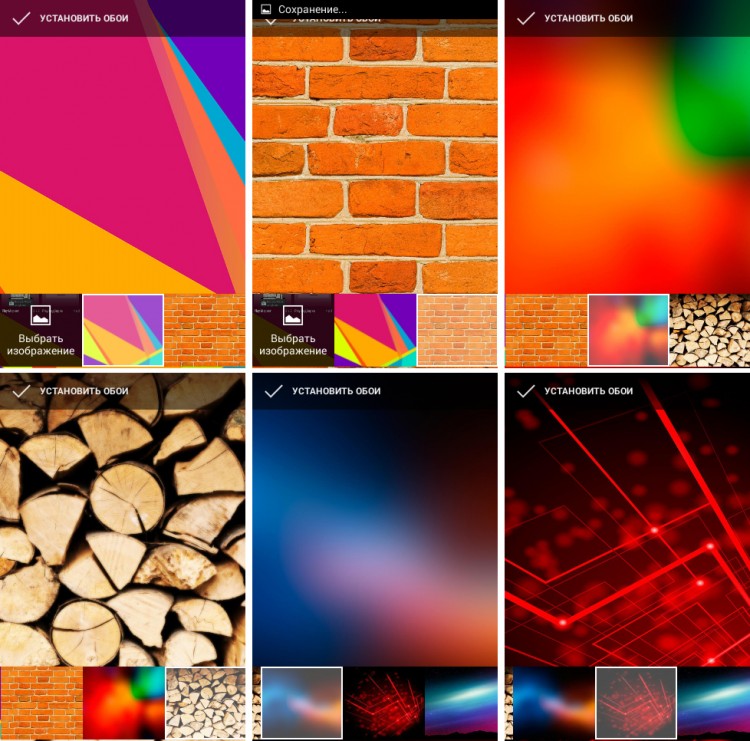
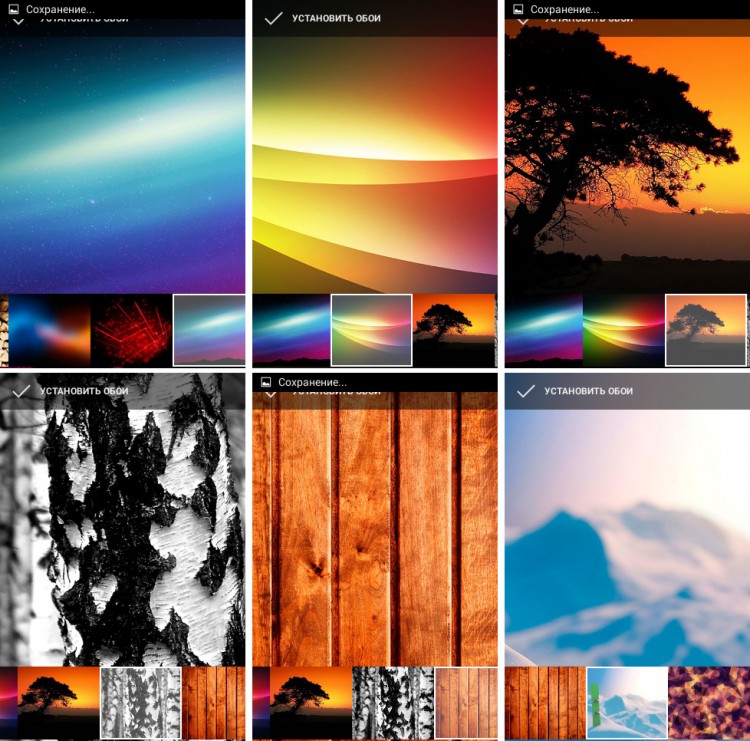
The interface of HIGHSCREEN PURE J is quite familiar, it is not difficult to navigate the menu at all. The layout and design is the same as on other Android devices.
Usage
Since the rear panel is slightly expanded, the smartphone is comfortable to hold, which is especially important when making calls.
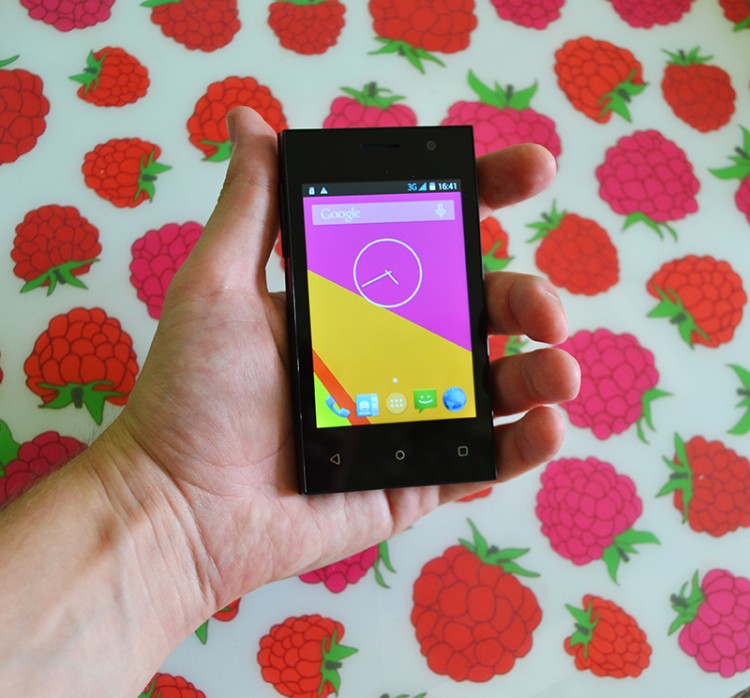
As I said earlier, the device has modest dimensions, and thanks to this, HIGHSCREEN PURE J will fit even in a small trouser pocket or bag.
As expected, the quality of communication at the level. The subscriber is perfectly audible not only through the speaker, but also through the headset that comes with the kit. In general, the ability to use SIM-cards of two different formats in one case turned out to be very convenient, especially if you take such a phone on a trip.
Web surfing is possible, pages open quickly enough, delays in work begin while browsing several pages at the same time. Of course, the screen is small, but it is possible to view the necessary information.
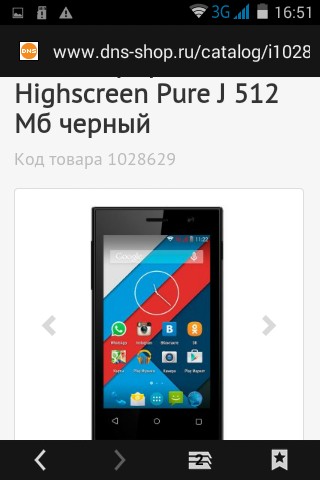

Games run, but not with complex graphics. But there were no casual problems.
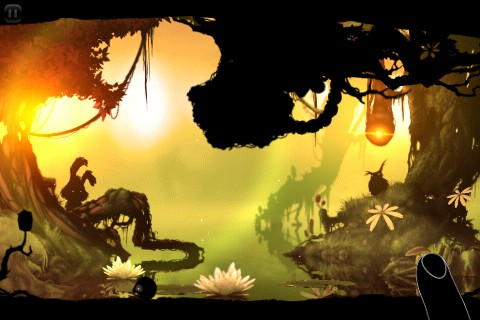
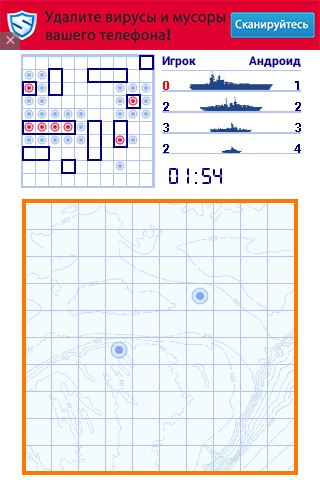
Again, I repeat that due to the small diagonal of the screen game process may be difficult. Naturally, if you buy a smartphone for the game, it will be a completely different model and, accordingly, a different price.
Camera
HIGHSCREEN PURE J has two cameras. The main one is 2 megapixels equipped with LED flash, and the front one is 0.3 megapixels. The quality of the picture during video calls is quite sufficient to see the interlocutor, and more is not needed. As for the main one, the quality of pictures and videos leaves much to be desired. But for a device with such a low price, this is the norm.
Camera settings turned out to be more than expected.
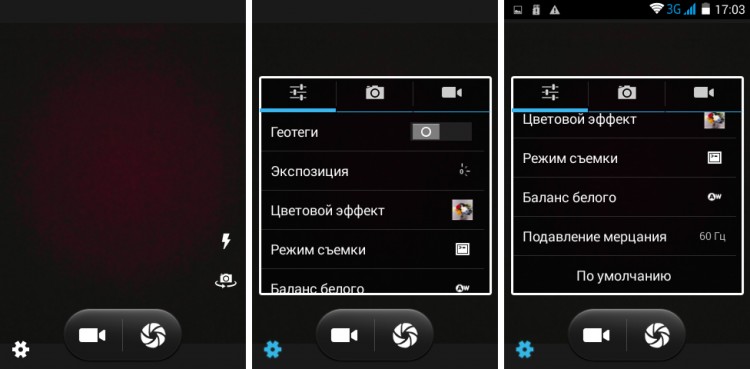
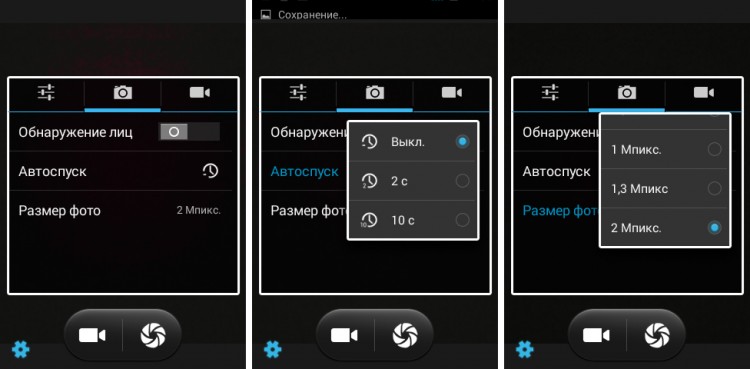
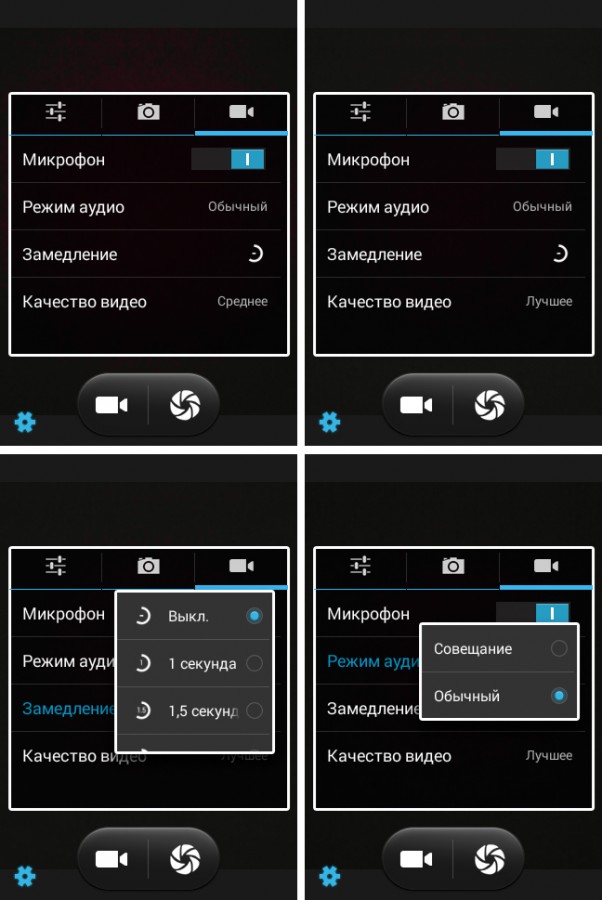
Photo in normal lighting.

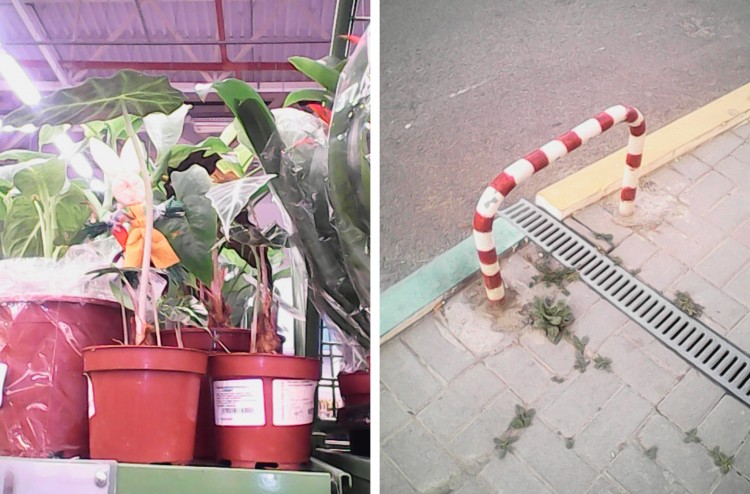
Photos taken in low light conditions.
![]()
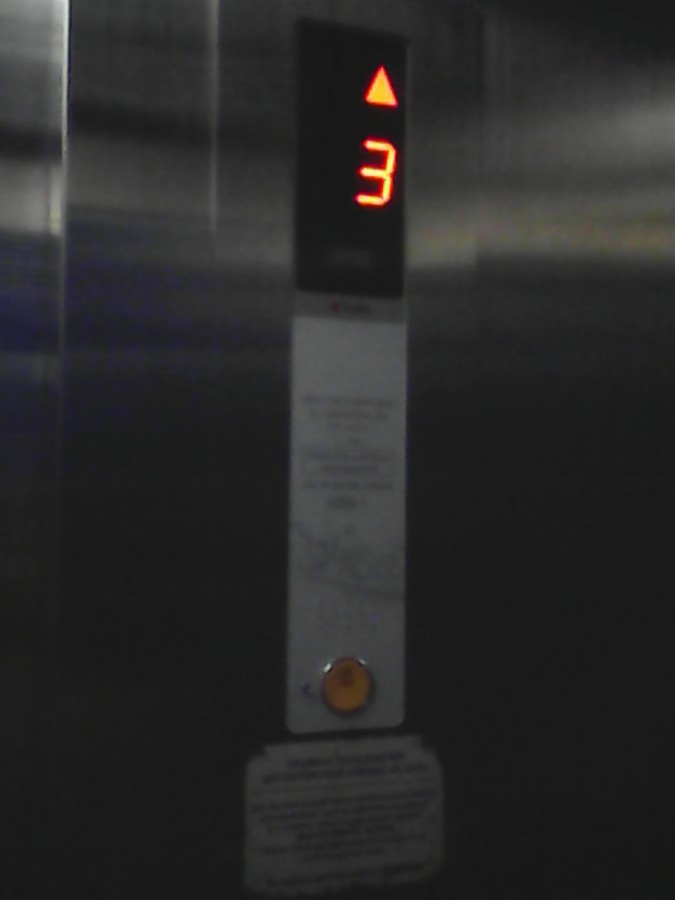
Photos taken with the front camera.

- Body materials: plastic
- Operating system: Google Android 4.4
- Network: GSM / GPRS / EDGE / 3G, two SIM cards of the miniSIM + microSIM standard
- Processor: 2 cores, MediaTek MT6572M
- RAM: 256 MB
- Storage Memory: 512MB
- Interfaces: Wi-Fi (b / g / n), Bluetooth 4.0, microUSB connector (USB 2.0) for charging / synchronization, 3.5 mm for a headset
- Screen: capacitive, IPS 3.5 "" with a resolution of 240x320 pixels
- Camera: 2/0.3 MP, flash
- Navigation: GPS
- Optional: accelerometer, proximity and light sensors, FM radio
- Battery: removable, lithium-ion (Li-Ion) 1300 mAh
- Dimensions: 111x61x9.9mm
- Weight: 115g
Introduction
Last year, a miniature smartphone from Vobis Computer (Highscreen) came out, accidentally left without my attention. However, no wonder: many observers have bypassed it, because the gadget has rather simple technical characteristics. At the moment, Pure J costs less than 3,000 rubles. For whom is this model suitable? It seems to me that those who are completely uninterested in processors, chips, memory, IPS or AMOLED matrices, cameras, and so on, but Android is important to install a couple of important programs, two SIM cards, extremely small dimensions and at least a more or less decent appearance . Of course, the design of Pure J is also not all right, but the user can choose one of the five colors of the back cover: black, white, orange, blue or yellow.
Design, dimensions, controls
The Pure J smartphone inherits the design of the Pure F, which, in turn, retained the external resemblance to the Jolla device on Sailfish OS. That is, the case consists of two halves: the back side is rectangular, and the reverse side is flat, but the corners are decorated with a semicircle. It turns out a two-layer "pie". Looks good.




As I wrote in the introduction, the device is available in several colors, or rather, covers of different colors are available. Alas, you will not find an additional panel in the kit, but it would be great, since Highscreen has already experimented in this direction. Probably, the manufacturer tried to save as much as possible on Pure J. As far as I know, all covers are matte, pleasant to the touch, the colors are quite bright.




Dimensions are small - 111x61x9.9 mm, after "shovels" like Samsung Galaxy Note, LG G4 or Meizu Pro Highscreen seems so small and easy to handle that it makes you want to use it for a while. However, it disappears when it becomes necessary to quickly type text on the keyboard, take photos, post them to colleagues at work, or something similar.
The weight of the phone is 115 grams, about the same as the Apple iPhone 5.
Despite the low cost, the Pure J screen has an oleophobic coating, and it is of good quality: prints are almost invisible, they are erased quickly, and the finger glides easily. Material - glass.
Assembled Pure J for a triple with a plus or a four with a minus. Over time, the lid began to creak. Everything else is good.

The loudspeaker is in the top center. It has a volume slightly above average, the quality is so-so: it creaks on ringing notes, the sound is booming. To the right of the speaker is the front camera.

Below the display are the control buttons. They are not illuminated, marked with silver paint.

Microphone - on the bottom, microUSB and 3.5 mm - on the top. On the left is the volume rocker, on the right is the power button. Relatively easy to use. Material - black glossy plastic.


On the reverse side there is a camera recessed into the case, a small LED flash, a slot where the speaker is located.


The back panel is removable. Below it at the top are slots for microSIM and miniSIM, as well as a microSD slot.


Display
This device uses a 3.5-inch screen. The physical size is 74x49 mm, the frame on top is 17 mm, on the bottom is 19 mm, on the right and left are about 6 mm each. There is no anti-reflective coating.
The Pure J display resolution from Highscreen is HVGA, that is, 320x480 pixels, the aspect ratio is 3:2, and the density is 164 pixels per inch. The matrix is not IPS, with an air gap.
The maximum brightness of white color is 350 cd/m2, the maximum brightness of black color is 0.65 cd/m2. Contrast - 550:1.
Since the matrix is not IPS, the picture, frankly, is disappointing: when the display deviates from itself, the colors fade sharply, when tilted towards itself, they are sharply inverted. The touch layer fulfills 2 touches.





Battery
This model uses a removable lithium-ion (Li-Ion) battery with a capacity of 1300 mAh. The manufacturer does not provide data on battery life.
In my conditions, Highscreen Pure J "lived" for about 8-9 hours: for the whole time about an hour of calls, 4-5 hours of 3G, a couple of hours of Wi-Fi, a camera - 20 minutes, about an hour of listening to music. In a more gentle mode, Pure F functions until the evening.

From a regular network adapter, the smartphone is charged up to 100% in about two hours.
Communication options
The device supports GSM/GPRS/EDGE (850/900/1800/1900 MHz); 3G/HSPA+ (900/2100 MHz). Otherwise, a typical Android set: Wi-Fi b / g / n, Bluetooth 4.0, GPS (satellites are reluctant to look for, but the accuracy is good). OTG mode does not work.



Memory and memory card
Inside, there is only 256 MB of RAM, which is only enough for a couple of applications in the background. Built-in memory is also small - 512 MB. Unfortunately, the camera will require a memory card to work, and for everything else. Naturally, there was a slot for it, the maximum volume is 32 GB.


cameras
The Highscreen Pure J device is equipped with two camera modules: the main one with 2 MP without autofocus, the front one with 0.3 MP. There is a flash.
The camera modules in this device are pain and sadness. Instead of 2 MP, there is probably 0.3 MP here (interpolation). If you take a picture of a sheet of A4 format, where the text is printed in 12-14 font, then most likely it will be difficult to make out the letters.
The device records video at a resolution of 854x480 pixels at 15 frames per second. The sound is great. The quality of the video is definitely higher than the photo. Therefore, it is better to make mini-rolls than photos :)


Photo examples
Performance
The Highscreen Pure F smartphone runs on the old Taiwanese MediaTek MT6572M chipset. It uses a dual-core processor with a clock speed of 1 GHz for each core. The graphics are Mali-400.
The interface slows down a little, slows down, there are shell friezes. By itself, the smartphone is slow, it is difficult to perform certain functions. But if the memory is not clogged with applications, then Pure J can be used without problems.
